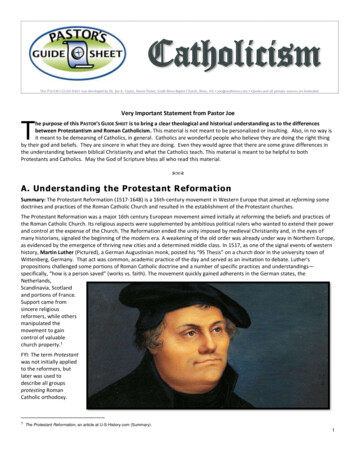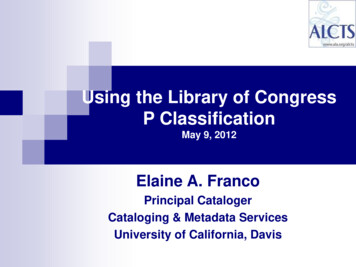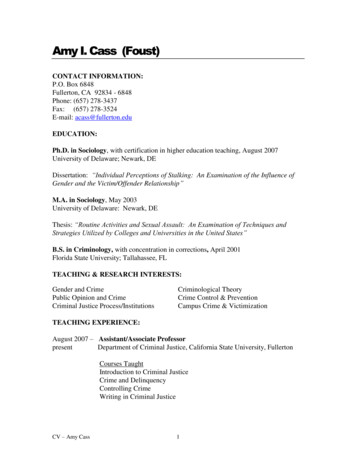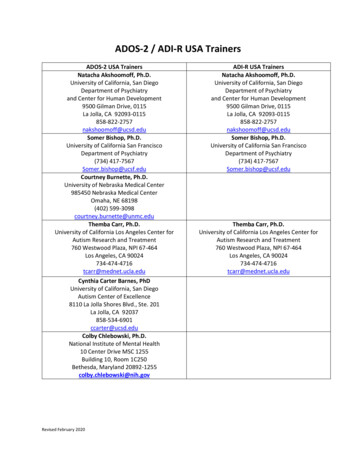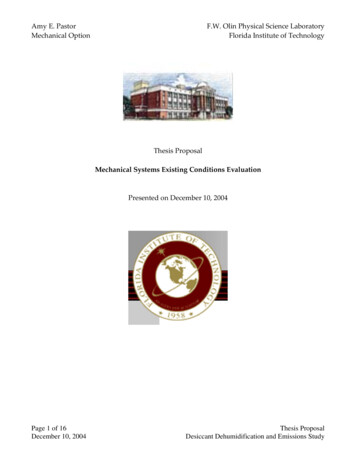
Transcription
Amy E. PastorMechanical OptionF.W. Olin Physical Science LaboratoryFlorida Institute of TechnologyThesis ProposalMechanical Systems Existing Conditions EvaluationPresented on December 10, 2004Page 1 of 16December 10, 2004Thesis ProposalDesiccant Dehumidification and Emissions Study
Amy E. PastorMechanical OptionF.W. Olin Physical Science LaboratoryFlorida Institute of TechnologyTable of ContentsExecutive Summary ‐ Depthp.3Executive Summary ‐ Breadthp.4Introduction & Backgroundp.5Thesis Proposal Alternativesp.7Breadth Area Proposal Alternativesp.10Thesis 16Page 2 of 16December 10, 2004Thesis ProposalDesiccant Dehumidification and Emissions Study
Amy E. PastorMechanical OptionF.W. Olin Physical Science LaboratoryFlorida Institute of TechnologyExecutive Summary ‐ DepthThe proposed redesign for the F.W. Olin Physical Science Lab includes a study of the currentmechanical system and the possible introduction of desiccant dehumidification into thesystem. Because this building is considered a lab, special precautions must be taken to reducethe amount of harmful chemicals emitted into the air. I will also conduct a study on theamount of chemical emissions that are being exhausted from the fume hoods throughout thebuilding.The Olin Science Lab is located in Melbourne, Florida on the Florida Institute of Technology’scampus. The dry bulb and mean wet bulb temperatures for Melbourne are 93/79 with ahumidity ratio of 155 grains of moisture per pound of dry air. This equates to about 55%relative humidity. Several bodies of water surround Melbourne including the Atlantic Oceanand the Indian River. With that added condition, along with the hot climate, I feel thatDesiccant Dehumidification would be a perfect option for this building.Since the Olin Science Lab is used to conduct experiments with harmful chemicals, fume hoodwere installed controlled by Phoenix Control Valves. I would like to conduct further researchon the amount of chemical gas that actually is exhausted into the ozone from the exhaustvents. My research will include finding the amount of gases that Florida allows by code to bePage 3 of 16December 10, 2004Thesis ProposalDesiccant Dehumidification and Emissions Study
Amy E. PastorMechanical OptionF.W. Olin Physical Science LaboratoryFlorida Institute of Technologyreleased into the air, finding if the Olin lab complies and further researching ways to lessen theharmful gases exhaustion if the lab does not comply.Executive Summary ‐ BreadthMy areas of breadth research are going to be in the electrical and lighting design areas.Adding a desiccant dehumidification system could possibly change my electrical system,therefore, a study will be completed. My hopes are that, with the reduction of energyconsumption in my mechanical redesign, the electrical system that is currently in the buildingwill be reduced. This will save in both space and money.I will also try to incorporate daylighting into the office spaces located throughout the building,hopefully reducing the amount of energy required by the chiller plant to be produced. Usinglight shelves and/or overhangs, the building will be able to collect the sun’s energy and help toreduce the cost of electric that is used for the building, in turn, reducing the size of theelectrical system, the first cost of the system and the operating cost.Page 4 of 16December 10, 2004Thesis ProposalDesiccant Dehumidification and Emissions Study
Amy E. PastorMechanical OptionF.W. Olin Physical Science LaboratoryFlorida Institute of TechnologyIntroduction and BackgroundThe F.W. Olin Physical Science Lab is located in Melbourne, Florida. Owned by the FloridaInstitute of Technology, the lab was built so that students and faculty could have a place toperform their experimentations and do research. Funding for the building was gained fromthe F.W. Olin Foundation, as was the Engineering Building next to it. The total cost of thebuilding was 14 million.The Olin Science Lab is approximately 69348 square feet. The fourth floor houses anobservatory with a pre‐engineered domed one‐meter telescope. On the rest of the three floors,25 chemical and physical science labs can be found equipped with fume hoods. These fumehoods are controlled by Phoenix Control Valves and help to prevent the escape of harmfulchemicals into the laboratory space.As mentioned above, the Olin Physical Science Lab is owned by the Florida Institute ofTechnology. Listed below are the other prime players involved in the development of the OlinLab.‐‐‐‐‐‐‐General Contractor: The Weitz Company, Inc.Architects: Schwab, Twitty & HanserLandscape Architects: Hall & BellMEP Firm: TLC Engineering for ArchitectureStructural Engineers: O’Donnell, Naccarato, Mignogna & Jackson, Inc.Civil/Surveyor Engineers: Baskerville Donovan, Inc.Geotechnical Group: Ardaman & Assoc.Page 5 of 16December 10, 2004Thesis ProposalDesiccant Dehumidification and Emissions Study
Amy E. PastorMechanical OptionF.W. Olin Physical Science LaboratoryFlorida Institute of TechnologyBecause of code, the Lab Building is a cast‐in place concrete structure with a brick veneer. Theexterior wall is made of CMUs with cement plaster. The domed telescope makes the buildingstand out from the rest of the engineering and science buildings surrounding the Olin Lab.On the first thru third floors of the Olin Lab, there are mechanical rooms at the far ends of eachcorridor that house a total of 8 Air Handling Units, three on the first and third floors and twoon the second floor. Below you will find a table with the data for each of the AHUs.Along with the mechanical equipment in the building, there is also a chiller building thathouses the following equipment:-(2) – 1200 GPM roof‐mounted Marley Cooling Towers(2) – 400 ton water‐cooled chillers(2) – Primary Chilled Water Pumps(2) – Secondary Chilled Water Pumps(2) – Condenser Water Pumps(1) – Gas‐fired, hot water boiler at 4500 MBH(2) – Hot Water Pumps(2) – Secondary Hot Water PumpsPage 6 of 16December 10, 2004Thesis ProposalDesiccant Dehumidification and Emissions Study
Amy E. PastorMechanical OptionF.W. Olin Physical Science LaboratoryFlorida Institute of TechnologyThesis Proposal AlternativesI have considered a few options for the redesign of the F.W. Olin Physical Science Lab. Thealternatives are as follows:Alternative #1: Desiccant DehumidificationCurrently, the mechanical system does not have any desiccant dehumidification. With theamount of humidity and the warm climate that occurs in Florida all year, desiccantdehumidification would be a perfect fit. I will analyze my building and change the mechanicalsystem to include a desiccant wheel. My hope is that adding the wheel helps to reduce theenergy used in the building, while also lowering the first cost of the mechanical system. I planto do extensive research on desiccant wheels and their applications. I also plan to research thepossibility of replacing some of my air handling units with a humidity control unit, againhopefully proving to be cost effective.Alternative #2: Chiller Plant Optimization and Thermal Energy StorageIn a recent class final project, I discovered that I could save about 173000 kBTU of energyconsumption by replacing my chillers. Currently being installed into the Olin Science Lab’schiller building are two centrifugal chillers. After researching and analyzing several options, Ifound out that replacing my centrifugal chillers with reciprocating chillers will save more thanPage 7 of 16December 10, 2004Thesis ProposalDesiccant Dehumidification and Emissions Study
Amy E. PastorMechanical OptionF.W. Olin Physical Science LaboratoryFlorida Institute of Technology173000 kBTU of energy consumption per year. With this in mind, I will analyze my chillerplant and attempt to optimize it for the best energy performance.In doing so, if I can save that much energy from being consumed, I will consider thermalenergy storage. The excess energy can then be reused and stored in tanks. This will hopefullyreduce the cost of the energy.Alternative #3: DOAS Radiant PanelsWhile my building is in Florida, it might be the optimal location for DOAS radiant panels. TheOlin Science Lab is currently equipped with five 100% outdoor air units. A certain amount ofventilation is necessary in a lab as it is in any space. I would like to consider changing theremaining three units to 100% outdoor air units. This would get rid of the VAV boxes that arecurrently being installed in the ductwork. It will also help to reduce the amount of ductworkthat is need. I will be able to replace the return duct with a plenum, therefore saving moneyfor the cost of the sheet metal used in the production of ducts. If the cost for the removedreturn ductwork offsets the cost of the radiant panels, I would then recommend converting thebuilding to a 100% outdoor air building with DOAS radiant panels.Page 8 of 16December 10, 2004Thesis ProposalDesiccant Dehumidification and Emissions Study
Amy E. PastorMechanical OptionF.W. Olin Physical Science LaboratoryFlorida Institute of TechnologyAlternative #4: An Above Alternative with the Addition of a Study on the Chemical EmissionsExhausted from the Fume HoodsAs another portion of my thesis, I would like to examine the amount of chemical emissionsthat are actually being released into the ozone from the exhaust system and the PhoenixControl Valves. As I will show, Phoenix Control Valves are top of the line when it comes tokeeping the harmful gases inside the fume hood. What I would like to research is the waythey handle releasing all that harmful gas into the air. I plan on doing research to find theamount of CO2 that is allowed to be released into the air by code in the state of Florida. I willthen test to see if the Olin Science Lab meets that criterion. If it does not, I will offer a redesignof the exhaust system with better filters to hopefully lessen their chance of being fined.Coupling this with Alternative #1, #2 or #3 will prove to be an interesting thesis.Page 9 of 16December 10, 2004Thesis ProposalDesiccant Dehumidification and Emissions Study
Amy E. PastorMechanical OptionF.W. Olin Physical Science LaboratoryFlorida Institute of TechnologyBreadth Area Proposal AlternativesAs with my depth area of research, I have been considering a few options for my breadth area.They are also as follows:Breadth Alternative #1: Electrical Analysis and RedesignMy redesign of the mechanical system might prove to save some energy and hopefully, lessenthe amount of electricity needed to run the building. As part of my breadth studies, I willconduct research on the electrical system of the building and how I can redesign it to be morecost effective and save space and energy.Breadth Alternative #2: DaylightingAnother area that I would like to study for my breadth is the option of daylighting. There areseveral office spaces throughout the three floors of classroom space. Since Florida is the“Sunshine State”, I will conduct research on the amount of energy that can be collectedthrough daylighting. Two of the options I will be looking at are light shelves and windowoverhangs. This option would tie in great with whichever mechanical option I choose becausethe effects of the daylighting redesign might be shown in the building envelope load.Page 10 of 16December 10, 2004Thesis ProposalDesiccant Dehumidification and Emissions Study
Amy E. PastorMechanical OptionF.W. Olin Physical Science LaboratoryFlorida Institute of TechnologyBreadth Alternative #3: Structural Analysis and RedesignSince there is a possibility that I will be changing one or more of my air handling units, placingthem on the roof might be the best option. Currently, there are no roof‐mounted air handlingunits on the F.W. Olin Physical Science Lab (as mentioned before, there are roof‐mountedcooling towers on the Chiller Building). With this in mind, some space could be saved byoffering the option of rooftop units with chases for the ductwork to run between floors anddown from the roof.Page 11 of 16December 10, 2004Thesis ProposalDesiccant Dehumidification and Emissions Study
Amy E. PastorMechanical OptionF.W. Olin Physical Science LaboratoryFlorida Institute of TechnologyThesis ProposalAfter considering all the options for my thesis proposal, I have decided that the mostinteresting and challenging will be the last alternative, Alternative #4. Coupled with thechemical emissions testing, I will choose to redesign the F.W. Olin Physical Science Lab usingDesiccant Dehumidification (Alternative #1). This option seems to be the most fitting for theenvironment that the building is in: constantly warm and humid climate.For my breadth areas, I proposed to do a study on the electrical systems and analyze theoption of daylighting (Alternatives #1 and #2). I opted not to do Alternative #3 because of theobservatory level that is located on the fourth floor. The observatory level is an open spaceand in order to run chases down from the roof, it might interfere with the look of the space,not to mention the positioning of the future telescopes that FIT plans to add.I feel that this work is justifiable because, along with cutting operating costs, energyconsumption will be reduced as well as providing more comfort for students in the humidenvironment of Florida.As tools for my research, I will use HAP to analyze the different systems that I am using in myredesign. This will help to establish if my energy consumption load has decreased along withPage 12 of 16December 10, 2004Thesis ProposalDesiccant Dehumidification and Emissions Study
Amy E. PastorMechanical OptionF.W. Olin Physical Science LaboratoryFlorida Institute of Technologythe decrease in the energy cost. Another tool I plan to use is basic hand calculations withreference to ASHRAE Fundamentals and loads for calculation provided in Chapter 29.I understand the difficulty of both of these methods. Hand calculations tend to take a longtime and are even longer to record in an electronic way. A HAP analysis also takes a long timeto complete, especially with all the data that will be input because of the size and use of mybuilding.If there are any limitations, it will be due to the fact that the building is still underconstruction. The mechanical equipment schedules that I have are the most current and arebeing used to buy the equipment, but addendums might have been made or a differentmanufacturer might have been chosen. In any case, I will use the most recent and mostaccurate information that I have in my possession.I feel that this thesis problem will prove to be both challenging and suitable to fulfill therequirements necessary to complete AE 482.Page 13 of 16December 10, 2004Thesis ProposalDesiccant Dehumidification and Emissions Study
Amy E. PastorMechanical OptionF.W. Olin Physical Science LaboratoryFlorida Institute of TechnologyConclusionAs stated above in my thesis proposal, I plan on doing a redesign of the Olin Lab usingdesiccant dehumidification. I will also conduct a study on the chemical emissions that thePhoenix Control Valves are exhausting into the ozone to see if they meet the standards set bythe Florida Building Code.In addition to the areas for my depth research, I will also be analyzing the electrical system inthe building and how my new redesign affects it. I will also be completing a study on theaffects of daylighting in the office spaces and how they can potentially conserve some energyin the building.Page 14 of 16December 10, 2004Thesis ProposalDesiccant Dehumidification and Emissions Study
Amy E. PastorMechanical OptionF.W. Olin Physical Science LaboratoryFlorida Institute of TechnologyReferencesAir Movement & Control Association (AMCA). 2004. Independent Control of Humidity,Temperature in New Compact, Packaged Design. A Supplement of Engineered Systems: pg. 16AMCA. 2004. Desiccant Dehumidification Systems Resolve Mold Issues at School. ASupplement of Engineered Systems: pg. 10AMCA. 2004. Lion’s Choice Restaurants Restore Comfort by Combining Dehumidificationwith A/C. A Supplement of Engineered Systems: pg. 12‐14AMCA. 2004. H20 Liquidaire System Captures Water from Air. A Supplement of EngineeredSystems: pg. 8Fischer, J. 2000. Active Desiccant‐Based Preconditioning Market Analysis and ProductDevelopment. SEMCO, Inc.Freihaut, J. 2004. Technical Consultation.West, M. 2004. Specifying Desiccant Dehumidifiers. HPAC Engineering.Page 15 of 16December 10, 2004Thesis ProposalDesiccant Dehumidification and Emissions Study
Amy E. PastorMechanical OptionF.W. Olin Physical Science LaboratoryFlorida Institute of TechnologySchedule for Proposed Work: Spring SemesterPage 16 of 16December 10, 2004Thesis ProposalDesiccant Dehumidification and Emissions Study
JanuaryFebruaryMarchApril10 to 16 17 to 23 24 to 30 Jan 31 to 6 7 to 13 14 to 20 21 to 27 Feb 28 to 6 7 to 13 14 to 20 20 to 27 28 to Apr 3 4 to 11 11 to 17General ResearchResearch on Desiccant DehumidificationFaculty ConsultationsSimulation/Analysis of Desiccant Wheel AdditionCost AnalysisSPRResearch for Chemical Emissions TestingPerforming Chemical Emissions TestingRedesign of Exhaust System (if code not met)Cost Analysis for RedesignRedesign of Mech. System (Desiccant Wheel Addition)Breadth Work (Electrical)Cost AnalysisBreadth Work (Daylighting)Cost AnalysisINGBRTotal Evaluation of the BuildingTotal Cost Analysis of BuildingFeasibility of AnalysisFinal Faculty ConsultationWriting ReportPrepare PresenationPresentationEAK
The Olin Science Lab is located in Melbourne, Florida on the Florida Institute of Technology's campus. The dry bulb and mean wet bulb temperatures for Melbourne are 93/79 with a humidity ratio of 155 grains of moisture per pound of dry air. This equates to about 55% relative humidity.


